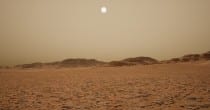As I stated at the start of the summer break, my recent work on landscapes was to prepare me for the task of updating and improving my original attempt at created a Martian landscape two years ago:

One of the core improvements was going to be a more procedural approach to ensure I could mange the undertaking of adding sufficient details to a larger open world. In many ways, my previous summer experiments were overkill because there is no life on Mars. However, there are rocks and there are interesting geological features, all of which I intend to incorporate into my next attempt.
As a little warm up, I attempted to create a surface material totally procedurally using Substance Designer. My previous work with Megascans was fun and yielded some near-realistic results, but even with editing, there is little in the library (that I have access to) that would suggest the rocky surface of the Red planet. There are some sand, rock and clump surfaces I might edit for this challenge, but I need some key bespoke surfaces that look good extremely close-up.
I started by adapting what I learned in this tutorial video course from Allegorithmic themselves. It wasn’t necessarily for a Martian landscape but the highly procedural approach of authoring materials in Substance Designer meant that with a little work, I could tweak the results to generate something close to what I desired:

The beauty of procedural material authoring is the ability to combine and mask blends until you arrive at a result for a feature of the surface you desire. And that any change at the start of the network is automatically propagated throughout the network in near real-time (when working <4k).
I managed to balance the desired frequency of rocks with enough variation in shape, position, rotation and blend with the underlying sand/dust. There is plenty of high frequency normal data to help give the surface detail and look realistic under foot.
The following network illustrates the process and approach I undertook to arrive at the end design:

It might look daunting to a beginner but actually the graph is very simple in that it only focuses on 3 outputs: albedo, normal and roughness. The height and ambient occlusion are afterthoughts really and only included in case they are required later.
To see if this material stood-up to the task of looking good in near and distant situations, I duplicated my previous procedural landscape experiment and swapped out the grass and rock blend for this new material blended with darker rocks on the peaks (in place of snow):

I am quite happy with the results. The material provides a vast improvement in close proximity fidelity and lends itself to being blended for a distance variant.
The image below demonstrates the fidelity from just the albedo and normal maps at 4k:

I found this reference to inspire me with the colours of the environment and overall atmospheric conditions:

I will be using this reference image to continue improving the scene started today. Considering the scene features only a single, procedural material, I believe I can create a very convincing landscape over the next few weeks, ready for the next stage of this project (which I’ll announce soon).
